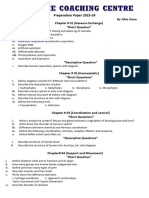Questions and their answers for a form four (equivalent to Grade 10) level.
These cover various
topics typically studied at this level, such as genetics, evolution, human biology, plant biology,
and ecology.
Genetics
1. Question: What is the basic unit of heredity? Answer: The gene.
2. Question: What is the process by which DNA is copied before cell division? Answer:
DNA replication.
3. Question: What are the two types of cell division? Answer: Mitosis and meiosis.
4. Question: What is a phenotype? Answer: The physical expression of a gene or set of
genes.
5. Question: What is a genotype? Answer: The genetic makeup of an organism.
Evolution
6. Question: What is the theory that explains the origin of species through gradual change
over time? Answer: The theory of evolution by natural selection.
7. Question: Who is known as the father of evolution? Answer: Charles Darwin.
8. Question: What is the term for the formation of new and distinct species in the course of
evolution? Answer: Speciation.
9. Question: What is the concept that organisms best adapted to their environment are more
likely to survive and reproduce? Answer: Survival of the fittest.
10. Question: What are homologous structures? Answer: Structures that are similar in
different species due to common ancestry.
Human Biology
11. Question: What is the function of red blood cells? Answer: To carry oxygen from the
lungs to the rest of the body.
12. Question: What is the largest organ in the human body? Answer: The skin.
13. Question: What part of the brain controls voluntary movements? Answer: The
cerebrum.
14. Question: What is the main function of the small intestine? Answer: Absorption of
nutrients and minerals from food.
15. Question: What hormone regulates blood sugar levels? Answer: Insulin.
Plant Biology
16. Question: What is the process by which plants make their food using sunlight? Answer:
Photosynthesis.
17. Question: What pigment is primarily responsible for absorbing light in photosynthesis?
Answer: Chlorophyll.
18. Question: What are the main parts of a plant cell that differentiate it from an animal cell?
Answer: Cell wall, chloroplasts, and a large central vacuole.
� 19. Question: What is the term for the movement of water from the roots to the leaves in
plants? Answer: Transpiration.
20. Question: What type of plant tissue is responsible for the transport of water and
nutrients? Answer: Xylem and phloem.
Ecology
21. Question: What is the term for a community of living organisms interacting with their
physical environment? Answer: An ecosystem.
22. Question: What is the role of producers in an ecosystem? Answer: To convert solar
energy into chemical energy through photosynthesis.
23. Question: What is a food chain? Answer: A linear sequence of organisms through which
nutrients and energy pass as one organism eats another.
24. Question: What is the term for non-living components of an ecosystem? Answer:
Abiotic factors.
25. Question: What is biodiversity? Answer: The variety of life in a particular habitat or
ecosystem.
Miscellaneous
26. Question: What molecule carries genetic information in most living organisms? Answer:
DNA (Deoxyribonucleic acid).
27. Question: What is the function of ribosomes in a cell? Answer: To synthesize proteins.
28. Question: What is the powerhouse of the cell? Answer: The mitochondrion.
29. Question: What process do cells use to break down glucose into energy? Answer:
Cellular respiration.
30. Question: What is the role of enzymes in biological reactions? Answer: To act as
catalysts and speed up chemical reactions.























































































